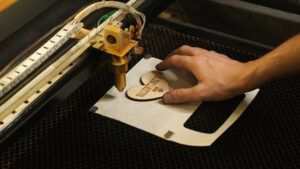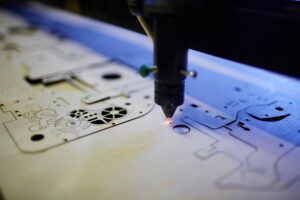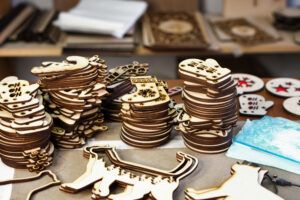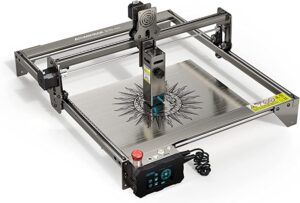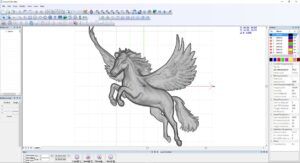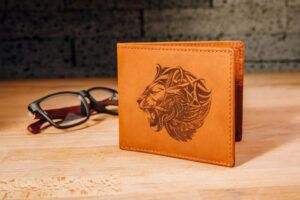Understanding the differences between the various types of laser engraving/cutting machines on the market is important before investing in one.
No matter if it’s your first time purchasing something like this or you already have some experience, it’s always worth taking the time to learn what different laser models have to offer and how to get the most out of them.
4 Different Types of Laser Engraving Machines
1 – Fiber Laser Engraving Machine

- Extremely fast working speed
- High level of detail
- Low running costs
- Low initial price
- Not as good at more complex cutting jobs
- Can’t cut most materials, except thin metal
- Doesn’t work well on transparent materials
Fiber lasers are very popular among those who prefer to work on a small bed size and don’t insist on working with transparent or delicate materials. They work by sending light through a series of fiber optic cables which concentrate the light from several emitters at the output, producing a laser beam.
This type of laser is usually not very good for cutting. The only exception is if you want to cut thin metal sheets. For anything beyond that, a fiber laser will not do a good job and will most likely not even make it through the working material.
When it comes to engraving, fiber lasers work very well on materials like aluminum, copper, stainless steel, titanium, and other types of metals. On the other hand, they’re not very good when it comes to wood, glass, plastic, paper, or anything transparent.
They have a smaller focal point than most other laser types, which results in a high level of detail. This is an important feature if you’re planning to engrave small, precise graphics that you don’t want to see distorted.
One great advantage of fiber laser engravers is their fast speed of operation, thanks to the galvo head mirror setup used in most models. It allows the laser to cover its working area extremely quickly. For some graphics, it might even look like the laser works instantaneously.
Compatible Materials
Aluminum, copper, stainless steel, titanium, some types of ceramics, carbon fiber
2 – Diode Laser Engraving Machine



- Relatively inexpensive
- Small and lightweight
- Supports engraving larger areas in batches
- Not very powerful
- Smaller range of supported materials
A diode laser is a laser that uses a diode as its main source of light. Diode lasers can work in various spectrums – for example, some operate specifically in the UV range, as described below. Most of these machines use an open gantry design, though there are some exceptions on the market. You may find some models that have a large housing around the main mechanism.
Due to the overall low complexity of the design of diode lasers, they tend to be relatively small, lightweight and portable. This makes them perfect for situations where you need to work on the go. They are also cheap, so if you are buying your first laser engraver/cutter and have a limited budget, you will likely want to consider a diode model first.
Diode lasers are also more customizable. In some models, you can swap out the laser module for a more powerful one. This can allow you to start with a relatively low investment, gradually purchasing more powerful components as your business (hopefully) takes off.
One great feature of most diode lasers is that you’re not limited to the base working area for your creations. You can engrave something much larger than your engraving bed. You just need to split up the graphic with the help of specialized software. Many programs on the market can do that easily. You then just need to move the working material beneath the laser as instructed by the engraving program.
Compatible Materials
Wood, plywood, leather, paper, glass, steel, some types of ceramics
3 – UV Laser Engraving Machine



- Supports most types of materials
- Perfect for precision work and delicate materials
- Doesn’t consume a lot of power
- Low maintenance requirements
- Large and bulky
- Weaker when working with metal
UV lasers are a subset of diode lasers. Light is generated by means of a diode that specifically emits in the UV spectrum. One of the main advantages of UV lasers is that they don’t cause any heat damage to the working material.
These types of lasers attempt to simulate the natural process of chipping away at the material, which results in a fine cut that works well for a variety of different materials. This includes more delicate ones which would normally get burned up by other types of lasers.
Like with regular diode lasers, a downside to UV lasers is that they require cooling to work properly. That’s why most units are relatively large and bulky. But as long as you have enough room to work with your laser cutter, a UV laser can be a great addition to your arsenal.
UV lasers can work on a wide range of materials, including many types of metals, plastic, stone, glass, paper, and various others. It’s a more general-purpose type of laser that’s suitable for people who want to work on a variety of different products.
Compatible Materials
Plastics, metals, wood, fabric, glass, paper, stone
4 – CO2 Laser Engraving Machine



- Great for small details and sharp angles
- High quality cuts for thicker materials
- Stable, proven technology
- Good CO2 laser machines are very expensive
- Consumes a lot of power
- Must replace tube regularly
CO2 lasers work by utilizing compressed gas in an elongated tube. They often come with a gantry system, though that’s not guaranteed. With the exception of metal, CO2 lasers are compatible with a great variety of materials, making them one of the most versatile types of lasers on the market.
They are especially good for engraving organic materials like food and leather, as well as other soft materials. Unfortunately, CO2 lasers can’t engrave metal. They also rely on air assist functionality more heavily than other types of lasers. However, they make up for that with their more powerful capabilities, resulting in a wider range of supported materials.
And while there are some cheap CO2 laser models on the market, they are generally more expensive than other types. Starter models won’t get you very far, and it’s recommended to upgrade to a more advanced version as soon as possible. And as you’ll quickly see, the price can rise very fast once you get out of that initial entry-level bracket.
CO2 lasers are also large and bulky, and are limited to the size of the main working area. You will have to replace the tube from time to time as it loses its performance, which makes those lasers more expensive to maintain in the long run.
Compatible Materials
Acrylic, wood, leather, fabric, glass, stone, rubber, cork
Conclusion
Choosing the right type of laser engraver/cutter can make a huge difference whether you’re just starting out or already have some experience.
There are various considerations to be made with regard to the range of supported materials, cost, and operation. Hopefully, this guide has given you sufficient insight into the situation to get you started!
